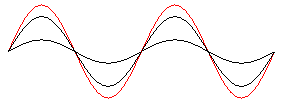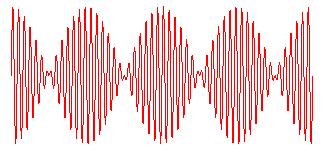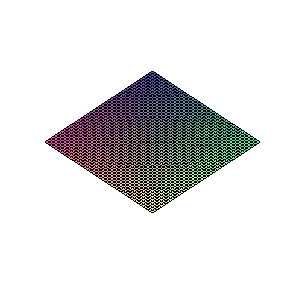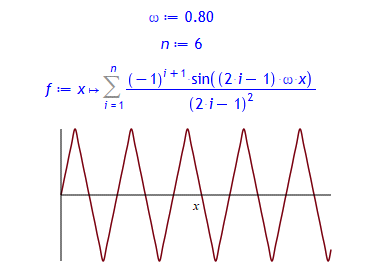Überlagerung von Schwingungen und Wellen
> restart; with(plots):
Überlagerung zweier eindimensionaler Wellen:
> y1:= x -> sin(x - 10*Pi*t):
y2:= x -> 3*sin(x - 4*Pi*t):
W1:= animate(y1(x), x = -2*Pi..2*Pi,
t = 0..1,
color = black,
frames = 200):
W2:= animate (y2(x), x = -2*Pi..2*Pi,
t = 0..1,
color = black,
frames = 200):
Wres:= animate (y1(x)+y2(x), x = -2*Pi..2*Pi,
t = 0..1,
color = red,
frames = 200):
display ([W1, W2, Wres], axes = NONE);
W1:= animate(y1(x), x = -2*Pi..2*Pi,
t = 0..1,
color = black,
frames = 200):
W2:= animate (y2(x), x = -2*Pi..2*Pi,
t = 0..1,
color = black,
frames = 200):
Wres:= animate (y1(x)+y2(x), x = -2*Pi..2*Pi,
t = 0..1,
color = red,
frames = 200):
display ([W1, W2, Wres], axes = NONE);

Stehende Welle
durch Überlagerung zweier gegenläufiger Wellen gleicher Wellenlänge und gleicher Frequenz:
> y1:= x -> sin(x - 2*Pi*t):
y2:= x -> sin(x + 2*Pi*t):
Wrechts:= animate (y1(x), x = -2*Pi..2*Pi,
t = 0..1,
color = black,
frames = 150):
Wlinks:= animate (y2(x), x = -2*Pi..2*Pi,
t = 0..1,
color = black,
frames = 150):
Wres:= animate (y1(x)+y2(x), x = -2*Pi..2*Pi,
t = 0..1,
color = red,
frames = 150):
display([Wrechts, Wlinks, Wres], axes = NONE);
Wrechts:= animate (y1(x), x = -2*Pi..2*Pi,
t = 0..1,
color = black,
frames = 150):
Wlinks:= animate (y2(x), x = -2*Pi..2*Pi,
t = 0..1,
color = black,
frames = 150):
Wres:= animate (y1(x)+y2(x), x = -2*Pi..2*Pi,
t = 0..1,
color = red,
frames = 150):
display([Wrechts, Wlinks, Wres], axes = NONE);

Schwebung
durch Überlagerung zweier Schwingungen mit wenig verschiedenen Frequenzen:
> n1:= 50:
n2:= 54:
y1:= x -> sin(n1*x):
y2:= x -> sin(n2*x):
plot(y1(x)+y2(x), x = -Pi..Pi, color = red, axes = NONE);
y1:= x -> sin(n1*x):
y2:= x -> sin(n2*x):
plot(y1(x)+y2(x), x = -Pi..Pi, color = red, axes = NONE);

Schwingungen im Raum
> animate3d (cos(t*x)*(6-abs(t))*y,
x = -Pi/2..Pi/2,
y = -1..1,
t = -6..6,
frames = 200);
y = -1..1,
t = -6..6,
frames = 200);

Dreieckschwingung durch Fourier-Synthese:
> omega:= .8;
n:= 6;
f:= x -> Sum((-1)^(i+1)*sin((2*i-1)*omega*x)/(2*i-1)^2, i = 1..n);
plot f(x), x = 0..12*Pi,
color = red,
numpoints = 1000,
tickmarks=[0, 0]);
f:= x -> Sum((-1)^(i+1)*sin((2*i-1)*omega*x)/(2*i-1)^2, i = 1..n);
plot f(x), x = 0..12*Pi,
color = red,
numpoints = 1000,
tickmarks=[0, 0]);

